![]()
![]()
![]()
Use LEFT and RIGHT arrow keys to navigate between flashcards;
Use UP and DOWN arrow keys to flip the card;
H to show hint;
A reads text to speech;
150 Cards in this Set
- Front
- Back
|
Ionization
|
neutral atom acquires a positive or negative charge
|
|
|
Direct Ionization
|
charged particles ie. electron, proton, alpha particle that have enough kinetic energy to produce ionization through collision as they penetrate matter
|
|
|
Indirect Ionization
|
uncharged particles... neutrons and photons... that liberate directly ionizing particles from matter when they interact with matter
|
|
|
The two basic sources of ionizing radiation
|
1. Natural or Background
2. Man-made radiation or X-rays |
|
|
Sources of background radiation
|
1. Cosmic radiation
2. Terrestrial 3. Internal |
|
|
Examples of electromagnetic radiation
|
radio waves
microwaves visible light x-rays ultrasound |
|
|
X-rays
|
electromagnetic radiation traveling at the speed of light in energy bundles moving through space as waves depositing energy randomly
|
|
|
3 things need to create x-rays
|
1. a source of electrons
2. a force to move them rapidly 3. something to stop them very rapidly |
|
|
Wavelength
|
the physical distance between peaks of the wave in meters
|
|
|
Amplitude
|
one half the range from the crest to the valley over which the sine wave varies
|
|
|
Frequency
|
the number of wavelengths that pass a point of observation per second
|
|
|
Velocity
|
speed of a photon as it travels through space
|
|
|
3 x 10^8 m/s
|
The speed of all electromagnetic radiation
|
|
|
Attenuation
|
the reduction in x-ray intensity that results from absorption and scattering
|
|
|
Inverse Square Law
|
decrease in intensity is inversely proportional to the square of the distance of the object from the source
Double the distance quarter the dose I1/I2 = (d2/d1)^2 |
|
|
X-ray quality
|
the penetrating ability of the radiation
|
|
|
Half Value Layer (HVL)
|
the thickness of an absorber of specified composition required to attenuate the intensity of the beam to half its original value
|
|
|
T/F All X-ray beams produced by radiation generators are heterogenous in energy
|
True
|
|
|
Quality is described by peak energy at which energy level?
|
Megavoltage
|
|
|
HVL=
|
0.693/u
|
|
|
Photon interactions
|
Photoelectric effect
Compton scattering Pair Production Photodisintegration Coherent scattering |
|
|
Photoelectric effect energy range
|
< or = 1 MeV like in diagnostic x-ray
|
|
|
Photoelectric effect
|

incoming photon interacts with an inner shell electron and transfers ALL its energy to that electron.
If energy absorbed is greater than the binding energy of the electron it is ejected. Energy of ejected electron is = to the energy of the incoming photon - the binding energy The inner shell electron is replaced by an outer shell electron and a Characteristic X-ray is produced. |
|
|
Auger Electron
|
a electron that is ejected by a characteristic X-ray in the photoelectric effect.
|
|
|
The most common interaction that occurs in radiation therapy?
|
Compton scattering
|
|
|
Compton scattering
|
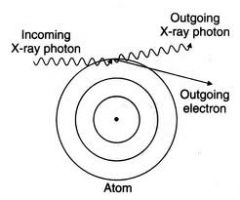
Incoming photon interacts with an outer shell electron whose binding energy is much less than the energy of the incoming electron.
The electron is ejected and the photon is scattered at an angle |
|
|
The 3 Types of interactions with Compton
|
Direct hit- Electron forward...photon backward
Grazing hit- Photon forward... electron emitted at a 90 degree angle 90 degree scatter- Photon scatters at 90 degrees from original direction |
|
|
Pair Production
|
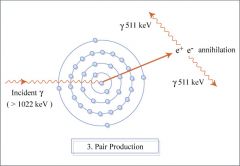
High energy photons interacting with the electromagnetic field of the nucleus.
Energy is absorbed and an is ejected as an electron and positron |
|
|
Pair Production energy level
|
> 1.022 MeV
|
|
|
Annihilation radiation
|
In pair production the positron produced can recombine with an electron and create 2 photons that are ejected in opposite directions with an energy of .511 MeV respectably.
|
|
|
Photodisintegration energy
|
> 10 MeV and have a high Z material
|
|
|
Photodisintegration
|
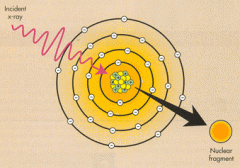
Incoming photon is absorbed by the nucleus and a neutron is emitted as a gamma ray
|
|
|
Thomas scattering
|
Also known as coherent scattering
|
|
|
Coherent scattering
|
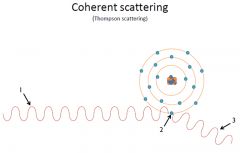
A low energy incident photon is absorbed by an electron and emitted in a new direction with the exact same energy
|
|
|
How do electrons interact with matter?
|
Through inelastic and elastic collisions
|
|
|
Elastic collisions
|
redistribute energy among particles emerging from the collision
High energy electrons decrease in energy at a rate of 2 MeV.cm in soft tissue |
|
|
Inelastic collisions
|
Kinetic energy is lost in production of ionization or is converted to other forms of energy
|
|
|
Heavy charged particles
|
Have an electric charge and an amu of at least 1
|
|
|
Heavy charged particle interaction
|
interact with atoms through coulomb forces between the electrical field of the particle and the atom
|
|
|
Stopping power (S)
|
The rate of kinetic energy loss per unit path length of the particle
|
|
|
Bragg peak
|
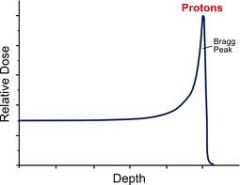
The peaking dose near the end of the particle range
|
|
|
Electron Interactions
|
Very similar to heavy particle interactions but because of small mass the electrons suffer greater multiple scattering and change of direction and as a result there is no Bragg peak
|
|
|
Neutron interactions
|
Interact by ejecting recoil protons or producing nuclear disintegration
|
|
|
Law of Bergonie & Tribonideau
|
Cells are most sensitive to radiation when they are actively proliferating and undifferentiated
|
|
|
LET
|
Linear Energy Transfer
The rate at which energy is deposited as a charged particle travels through matter |
|
|
RBE
|
Relative Biological Effectiveness
RBE = Dose of standard radiation necessary to produce a given effect / dose of test radiation necessary to produce the same effect |
|
|
LET and RBE
|
As LET increases so does the RBE
|
|
|
OER
|
Oxygen Enhancement Ratio
THe ratio of dose required for equivalent cell killing in the absence as compared to the presence of oxygen Oxygen is a radiosensitzer |
|
|
Deterministic radiation response
|
Threshold dose where the severity increases with increasing dose
example: radiation skin burns |
|
|
Stochastic radiation response
|
Severity independent of dose but probability increases with dose so NO threshold dose
example: cancer |
|
|
Somatic effects
|
Are late effects of radiation exposure to cells but are not transferred to future generation
example carcinogenesis |
|
|
Genetic effects
|
appear in the future generations of the exposed person as a result of radiation damage to the reproductive cells.
|
|
|
Radiation and the cell cycle
|
M phase is most sensitive to radiation
S phase is most resistant to radiation |
|
|
The 4 R's of radiobiology
|
Repair
Re-oxygenation Reassortment/Redistribution Repopulation |
|
|
Hemopoietic System
|
Blood, marrow and lymph
|
|
|
Radiation and bone barrow
|
Decreases the number of stem cells in marrow
Erythroblasts are the most radiation sensitive cells in marrow Megakaryocytes are the most radiation resistant cells in marrow |
|
|
Radiation and blood
|
Lymphocytes are the most radiosensitive
Decreased WBC increased infection risk Decreased RBC = anemia Decreased platelets increased hemorrhage risk |
|
|
Early responding tissues
|
Days- weeks
Epithelial cells e.g. skin reddening uncomfortable but rarely lethal and usually recoverable Tumors behave as an early reacting tissue |
|
|
Late responding tissues
|
months to years - fibrosis and organ failure
e.g. lung, spine, heart, kidney failure |
|
|
Acute skin reactions
|
inflammation
erythema (2000 cGy) dry desquamation (2000 cGy - 4000 cGy) moist desquamation (> 4000 cGy) |
|
|
Chronic skin reactions
|
Atrophy
fibrosis Hyper/hypo pigmentation necrosis |
|
|
Male permanent sterility
|
5-6 Gy
|
|
|
Male temporary sterility
|
2.5 Gy
|
|
|
Male reproduction and radiation
|
immature spermatagonia are very radiosensitive
possible genetic damage that could affect future generations |
|
|
Female sterility
|
6.25 Gy
|
|
|
Female reproduction and radiation
|
possible genetic damage that could affect future generations
Ovaries very radiosensitive |
|
|
The GI system and radiation
|
small bowel = most radiosensitive
Rectum and esophagus most radio resistant |
|
|
Most radio-resistant system in the body?
|
CNS
|
|
|
White and gray matter and radiation
|
Gray matter is more radio-resistant than white matter
|
|
|
TBI acute effects
|
Hematopoietic syndrome
Gastrointestinal syndrome Cerebrovascular syndrome |
|
|
Hematopoietic syndrom
|
2.5-5 Gy
Death in within a matter of weeks to months from a lack of immune system |
|
|
Gastrointestinal syndrome
|
5-12 Gy
Death within a matter of days due to destruction o gastrointestinal mucosa leading to intestinal failure |
|
|
Cerebrovascular syndrome
|
100 Gy
death in a matter of a day or two due to neurologic and cardiovascular breakdown |
|
|
Fetus and radiation
|
0-9 days = spontaneous abortion
10 days - 6 weeks (organogenesis) = congenital anomalies and growth retardation 6-40 weeks = growth and cognitive problems |
|
|
Carcinogenesis
|
The process by which normal cells are transformed into cancer cells
|
|
|
USA unit of exposure
|
Roentgen (R)
|
|
|
USA unit of absorbed dose
|
Rad (radiation absorbed dose)
|
|
|
USA biological equivalent dose
|
Rem (radiation equivalent man)
|
|
|
USA Unit of activity
|
Curie (Ci)
|
|
|
SI unit of absorbed dose
|
Gray (Gy)
|
|
|
SI unit of biological equivalent dose
|
Sievert (Sv)
|
|
|
SI unit of activity
|
Becquerel (Bq)
|
|
|
Absorbed dose (Gy)
|
one Gy = one joule of energy deposited in on kg of a material
1 Gy = 100 rads |
|
|
Exposure measurement (R)
|
Describes an amount of gamma and X-rays only in air
No equivalent unit in SI system Not used very often |
|
|
Equivalent dose (rem)
|
Relates absorbed dose in human tissue to effective biological damage
Not all radiation types have same biological effect 1 Sv = 100 rem |
|
|
Kerma (kinetic energy released per unit mass... of air)
|
Measure of amount of radiation energy in joules (J) actually deposited in or absorbed in a unit mass (kg) of air
expressed as J/kg which is the same as the gray (Gy) |
|
|
Personnel monitoring devices
|
Film badge dosimeter
TLD OSL pocket ionization chamber |
|
|
TLD (Thermoluminescent Dosimeter)
|
Traps electrons in their crystal when exposed to radiation
light is given off when heated -> amount of light determines radiation exposure more expensive than film badges less sensitive to heat and humidity sent out to be read |
|
|
OSL (optically stimulated luminescence) dosimeter
|
electrons trapped in the aluminum oxide when it is exposed to radiation
more sensitive than film can estimate dose at depths accurate within 1 mrem |
|
|
Geiger-Muller Counter
|
very sensitive and strongly energy dependent
can detect very small amounts of radiation |
|
|
Ionization chamber
|
composed of 2 electrodes, electronics and a meter that amplifies and measures the electrical signal
Should be run at a high voltage so the all the ion pair are collected and no recombine The sensitivity depends on the mass of gas in the chamber accurate within 2 % used to measure output of therapy equipment |
|
|
Diodes
|
composed of an anode and a cathode
used for relative dosimetry... output consistency checks and in vivo patient dose monitoring |
|
|
Neutron detector
|
used to detect neutron radiation
example: Scintillation neutron detector |
|
|
ALARA
|
As Low As Reasonably Achievable
|
|
|
Basic methods of protection for radiation exposure
|
Time
Distance Shielding |
|
|
CFR 10, parts 20 and 35
|
Facility and regulation guidelines
|
|
|
Shielding parameters
|
Use factor (U)
Workload (W) Occupancy factor (T) Effective dose (P) |
|
|
Use Factor (U)
|
the number of time in a day the radiation beam is directed toward a particular barrier
|
|
|
Workload (W)
|
the amount of patients per week multiplied by the amount of radiation for each person
|
|
|
Occupancy factor (T)
|
refers to the amount of time the rooms next to the treatment room are occupied
|
|
|
Effective dose (P)
|
The radiation limit for the occupied area
|
|
|
Use factors for primary barriers
|
Floor = 1
Walls = 1/4 Ceiling = 1/4-1/2 |
|
|
Primary barriers
|
protect against DIRECT exposure from the primary beam
|
|
|
Secondary barriers
|
Protect against leakage and scatter radiation
|
|
|
Occupational Exposure (stochastic)
|
Annual: 50 mSv or 5 rem
Cumulative: 10mSv x age / 1rem x age |
|
|
Occupational exposure (non-stochastic)
|
Lens of eye: 150 mSv or 15 rem
Skin, hands, feet: 500 mSv or 50 rem |
|
|
Annual public exposure
|
Effective dose for infrequent exposure: 1mSv or 100mrem
Effective dose for tissues: 5mSv or 500mrem Lens of eye: 15mSv or 50 mrem Skin and extremities: 50mSv or 5 rem |
|
|
18 or younger exposure
|
annual effect dose limit: 1mSv or 100mrem
|
|
|
Emryo/Fetus
|
total effective dose: 5mSv or 500mrem
Monthly effective dose: .05mSv or 50mrem |
|
|
Uncontrolled/unrestricted area
|
0.02 mSv/ week or 1mSv/year
areas occupied by the general public |
|
|
Controlled/restricted area
|
1 mSV or 100mrem/wk
barriers and engineering controls in place to reduce exposure |
|
|
Caution radiation area sign
|
exposure of more than 5mrem/ hr or 100 mrem in 5 days
|
|
|
Caution High radiation sign
|
greater than 100 mrem/hr
|
|
|
Radiation symbol colors
|
three-bladed symbol in magenta and a yellow background
|
|
|
Caution Radioactive material
|
when the quantity of the nucleotide exceeds the activity specified by local law
eg HDR room |
|
|
MSDS
|
Material Safety Data Sheets
intended to provide workers and emergency personnel with procedures for handling or working with that substance in a safe manner, and includes information such as physical data (melting point, boiling point, flash point, etc.), toxicity, health effects, first aid, reactivity, storage, disposal, protective equipment, and spill-handling procedures |
|
|
Shielding blocks
|
Composed of cerrobend
BLT w/ Cheese 50% Bismuth 26.7% Lead 13.3% Tin 10% Cadmium - Toxic! |
|
|
Radium 226
|
1622 yrs half life
.830 MeV |
|
|
Cobalt 60
|
5.27 yrs half life
1.25 MeV |
|
|
Cesium 137
|
30.0 yrs half life
.662 MeV |
|
|
Iridium 192
|
73.83 days half life
.380 MeV |
|
|
Iodine 125
|
59.4 days half life
.028 MeV |
|
|
Palladium 103
|
16.99 days half life
.021 MeV |
|
|
Gold 198
|
2.7 days half life
.412 MeV |
|
|
Radon 222
|
3.82 days
.78 MeV |
|

|

|
|
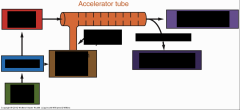
|

|
|
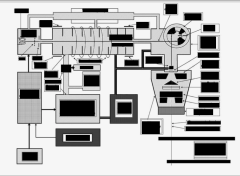
|

|
|
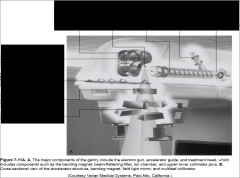
|
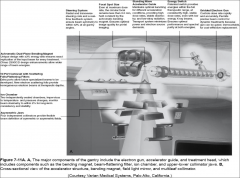
|
|
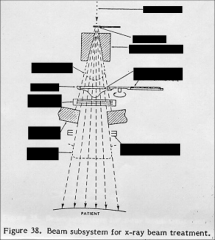
Photons
|

|
|
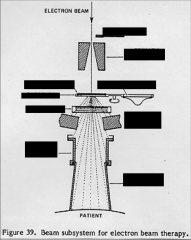
Electrons
|

|
|
|
5 main components of accelerator?
|
Drive stand
patient support assembly (PSA) Electronic cabinet Console |
|
|
Two types of bending magnets used?
|
90 or 270 degree bending magnet
|
|
|
___________ ______ _______________ keep track of dose rate and field symmetry
|
Monitoring ion chambers
|
|
|
_______________ _________________ are used to localize the target volume using fluoroscopy and/or static two-D radiographic imaging
|
Conventional simulators
|
|
|
Name to advantages to CT simulators compared to conventional simulators?
|
visualize 3-D data
easily see different tissue densities |
|
|
How often do the interlocks on the linear accelerator need to be checked?
|
Daily
|
|
|
T/F? A beam on indicator light is mandatory?
|
True
|
|
|
T/F? The emergency off switch is required to be tested daily?
|
False
|
|
|
Localizing lasers on simulators must be within_______________ of isocenter.
|
2mm
|
|
|
Full calibration and overhaul of treatment equipment must be carried out how often?
|
Annually
|
|
|
The components of a linear accelerator revolve around isocenter on their respective axes. What is the tolerance for locating the isocenter in these rotation is a sphere of?
|
2mm in diameter
|
|
|
How often do the electron and photon beams need to be checked on a linear accelerator?
|
Daily
|
|
|
What is the tolerance for the localizing laser on the ODI?
|
2mm
|
|
|
How does the linear accelerator generate a high energy photon or electron?
|
By accelerating charged particles in a linear path
|
|
|
T/F? as the distance from the source increases the penumbra decreases
|
False
|
|
|
What is the target in the linear accelerator made of?
|
Tungsten
|
|
|
What is the tolerance for the scan and couch vertical positioning accuracy for CT planning?
|
2mm
|
|
|
Door interlocks must be checked __________
|
Daily
|
|
|
Gantry and collimator angles must be accurate within how many degrees?
|
1 degree
|

